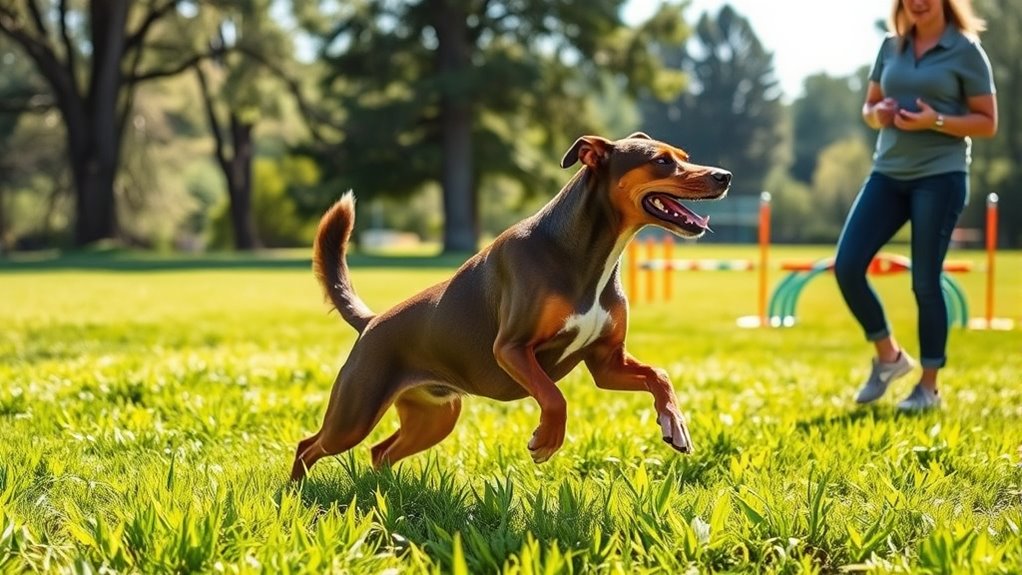Off-leash obedience training lets your dog enjoy outdoor freedom while staying safe and responsive. By teaching commands like “come,” “sit,” and “leave it,” you’ll build their reliability and confidence in various environments. Socialization plays a key role, helping your dog navigate different settings calmly. Starting in low distractions and gradually increasing difficulty guarantees safety and trust. Keep practicing and celebrating small wins, and you’ll discover how enjoyable off-leash adventures can become with proper training.
Key Takeaways
- Start training in low-distraction environments to build foundational obedience and confidence.
- Use consistent commands and positive reinforcement to improve responsiveness and reliability.
- Gradually introduce socialization and real-world scenarios to enhance safety and adaptability.
- Focus on reliable recall and commands like “leave it” and “wait” for off-leash safety.
- Foster patience and regular practice to strengthen the bond and ensure long-term off-leash success.

Off-leash obedience training can substantially enhance your dog’s freedom and your ability to enjoy outdoor activities together. When your dog masters reliable recall and responds promptly to obedience commands, you open up a world of safe, enjoyable experiences. One key benefit of off-leash training is improving your dog’s socialization skills. Well-socialized dogs tend to be calmer and more confident around other animals and people, making outings more pleasant for everyone. Proper socialization begins early, exposing your dog to various environments, sounds, and encounters with other dogs and humans. As you work on obedience commands like “sit,” “stay,” “come,” and “heel,” you’re not just teaching your dog to follow orders—you’re guiding them to navigate social situations appropriately. For example, practicing the “come” command in different settings builds reliable recall, so your dog responds promptly even amidst distractions. This dependability is vital for ensuring your dog’s safety, especially in off-leash scenarios where they might encounter other animals or unfamiliar environments.
Building a solid foundation in obedience commands also makes off-leash training more effective and safer. Commands like “leave it” help prevent your dog from approaching potentially dangerous objects or animals, while “wait” can stop them from rushing ahead or into unsafe situations. The process involves consistent, positive reinforcement, rewarding your dog when they obey, which encourages them to repeat those behaviors. As your dog becomes more responsive and confident with commands, you’ll notice their overall behavior improves, making off-leash outings less stressful. You’ll find it easier to keep your dog by your side, reducing the risk of them wandering off or getting into trouble.
Patience and regular practice are essential. Start training in low-distraction environments and gradually introduce more challenging settings. Socialization should be integrated into this process, allowing your dog to apply their obedience commands in real-world situations. Over time, you’ll see your dog become more balanced, less anxious, and more enthusiastic to explore safely. Remember, every dog learns at their own pace, so celebrate small successes and stay consistent. When your dog reliably responds to obedience commands and is well-socialized, off-leash adventures become a rewarding experience for both of you. This progress not only grants your dog more freedom but also deepens the trust and bond you share, making every outing a safe, enjoyable adventure.
Frequently Asked Questions
How Long Does Off-Leash Training Typically Take?
Off-leash training usually takes about 4 to 6 months, but the duration timeline varies based on your dog’s age, temperament, and prior training. You’ll notice key training milestones like improved recall, increased focus, and consistent obedience. Patience is key—regular practice and positive reinforcement help your dog progress steadily. Stay committed, and you’ll see your pup confidently obeying commands off-leash in different environments within this timeframe.
What if My Dog Ignores Commands Off-Leash?
Oh, your dog ignoring commands off-leash? Irony strikes again! Start by reinforcing recall often, making it rewarding and reliable. When distractions pop up, master distraction management by gradually introducing new environments and maintaining high-value treats. Patience is key—your pup learns best when you stay consistent and calm. Remember, it’s a journey, not a quick fix. With time and effort, your dog will listen, even amidst chaos.
Can Off-Leash Training Work for Aggressive Dogs?
Yes, off-leash training can work for aggressive dogs, but it requires careful aggression management and leash alternatives. You should start in a secure, fenced area and use positive reinforcement to build trust. Gradually, introduce off-leash exercises only after your dog reliably responds to commands on a leash. Always prioritize safety, and consider working with a professional trainer experienced in managing canine aggression to make certain effective, safe off-leash training.
Is Off-Leash Training Safe in All Environments?
Off-leash training isn’t safe in all environments. You need to take safety considerations like nearby traffic, other animals, and distractions that could cause your dog to run off or get hurt. Environmental factors, such as crowded parks or busy streets, can make off-leash training risky. Always assess the area first, make sure your dog responds reliably to commands, and use secure, enclosed spaces whenever possible to keep your dog safe.
How Do I Maintain Training Consistency Over Time?
Keep the ball rolling by sticking to your consistency strategies and making training reinforcement a daily habit. Remember, a chain is only as strong as its weakest link, so set clear routines and stick to them. Regular practice and positive reinforcement help your dog stay sharp. By maintaining this rhythm, you’ll see progress stick, turning good behaviors into lasting habits that stand the test of time.
Conclusion
Think of off-leash obedience training like opening a door—suddenly, your dog can explore freely, but with trust and control. I once watched a dog confidently run through a park, knowing his owner’s commands kept him safe. Studies show well-trained dogs are happier and more confident. With patience and consistency, you’ll see your pup become a reliable companion, ready to explore the world while staying safely by your side.









